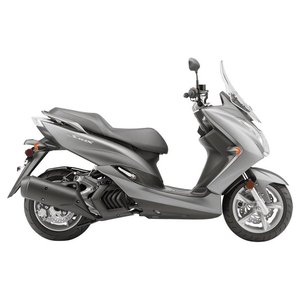Yamaha XC 155 SMAX (2015-2020): A Scooter That Balances Urban Agility and Touring Potential
Introduction
The Yamaha XC 155 SMAX, produced from 2015 to 2020, isn’t just a scooter—it’s a statement. Designed to bridge the gap between compact city commuters and long-distance maxi-scooters, this model generation carved out a niche for riders who demand versatility. After spending a week with a well-maintained 2018 example, it’s clear why the SMAX remains a favorite in the used market. From its peppy engine to its surprisingly spacious storage, this scooter challenges expectations at every turn. Let’s dive into what makes it tick—and why it might be your next two-wheeled companion.
Design & Aesthetics: Sleek, Sporty, and Surprisingly Practical
The SMAX’s design language screams “sporty commuter.” Its angular bodywork, dual LED headlights (a standout feature in its class), and chiseled lines give it a more aggressive stance than typical scooters. The 2020 Candy Red model I tested looked particularly sharp, with metallic finishes catching sunlight in a way that made it feel premium. Earlier models like the 2016 Gun Metal Gray or 2015 Matte Titanium offered subtler, urban-friendly palettes.
The 795mm (31.3-inch) seat height is approachable for most riders. At 5’8”, I could plant both feet firmly, which inspires confidence in stop-and-go traffic. The two-up seat is generously padded—a blessing on hour-long rides—though pillions might crave a backrest for longer journeys.
Under-seat storage is where the SMAX shines. The 32-liter compartment swallowed a full-face helmet and a laptop bag with room to spare. Compare that to the Honda PCX’s 28-liter space, and you’ve got a scooter that’s ready for Costco runs or weekend getaways.
Engine & Performance: Small Displacement, Big Personality
Yamaha’s 155cc liquid-cooled SOHC engine is the star here. With 11.0:1 compression and fuel injection, it delivers a satisfying 15.5 PS (estimated). But numbers don’t tell the full story. Twist the throttle, and the SMAX surges forward with an eagerness that belies its size. It’s no highway rocket—top speed hovers around 112 km/h (70 mph)—but 0-60 km/h (0-37 mph) acceleration feels quicker than the 2.90 L/100km (81.11 mpg) fuel economy suggests.
The V-Belt automatic transmission is butter-smooth. Unlike some CVT scooters that drone monotonously, the SMAX’s power delivery feels linear and intentional. Climbing hills? Drop your weight forward, and the engine hums along without protest. The liquid cooling system kept temps in check even during a 35°C (95°F) afternoon crawl through downtown traffic.
Handling & Ride Quality: A Surprise in the Corners
Here’s where the SMAX defies scooter stereotypes. The 13-inch wheels—120/70 front, 130/70 rear—provide stability that smaller 10-inch setups can’t match. Leaning into a sweeping curve at 65 km/h (40 mph), the chassis remained composed, aided by the 26-degree rake angle and 82mm (3.2-inch) trail. The Michelin City Grip tires on my test unit offered reassuring grip, though some owners swap them for sportier options like Pirelli Diablo Rosso Scooters.
Suspension travel—79mm (3.1 inches) up front, 60-94mm (2.4-3.7 inches) at the rear depending on model year—handled potholes better than expected. The 2020 model’s revised rear shock (94mm travel) felt plusher over broken pavement, a worthwhile update. Braking is confident with dual 245mm hydraulic discs; ABS wasn’t offered, but the combined braking system modulates power well.
Technology & Daily Practicality
While not tech-laden, the SMAX nails the essentials. The analog-digital dash is legible in direct sunlight, showing fuel level, odometer, and two trip meters. The 7.57L (2.0-gallon) tank seems small but delivers a 260-280 km (160-175-mile) range—enough for weekly commutes.
Yamaha’s dual headlights are a safety boon, casting a wide beam on unlit roads. The 2020 model’s optional windscreen (absent on earlier versions) reduced buffeting at speed. For customization, many owners add taller screens or USB ports—both popular MOTOPARTS.store items.
Competition: How the SMAX Stacks Up
Honda Forza 125
The Forza offers a larger windscreen and slightly plusher ride but trails in power (125cc vs. 155cc). Its 29L storage loses to the SMAX’s 32L. Forza wins in fuel efficiency (1.9L/100km), but at the cost of highway viability.
Suzuki Burgman 200
Burgman’s 200cc engine has more top-end pull, and its floorboard storage is genius. However, it’s 18kg (40 lbs) heavier than the SMAX, dulling urban agility. Maintenance costs also run higher.
Kymco X-Town 300i
A 300cc contender with ABS and keyless ignition, the X-Town targets touring riders. But its 195kg (430 lbs) weight and 799mm seat height make it less accessible. The SMAX strikes a better balance for city-dwellers.
Maintenance: Keeping Your SMAX in Prime Shape
Oil & Fluids
- Use SAE 10W-40 (1.5L capacity) every 4,000 km (2,500 miles). Synthetic blends like Motul 7100 improve longevity.
- Coolant changes every 24,000 km (15k miles)—stick with Yamaha’s OEM mix to prevent corrosion.
Belt & Drivetrain
The V-Belt lasts ~16,000 km (10k miles). Watch for sluggish acceleration or vibrations. MOTOPARTS.store stocks OEM-spec belts and installation tools.
Tires
- Front: 28 PSI (1.9 bar)
- Rear: 32 PSI (2.2 bar)
Upgrade to Michelin Power Pures for sportier handling.
Spark Plugs
NGK CPR9EA-9 replacements every 12,000 km (7.5k miles). Keep a spare in the under-seat storage!
Brakes
DOT 4 fluid changes every two years. EBC sintered pads improve bite in wet conditions.
Conclusion: A Scooter That Grows With You
The Yamaha SMAX isn’t just transportation—it’s a canvas. Whether you’re a student threading through traffic or a veteran rider adding a practical second bike, its blend of efficiency and verve keeps things interesting. While newer models have since emerged, the 2015-2020 generation remains a sweet spot for affordability and proven reliability.
Ready to make it yours? Explore MOTOPARTS.store’s curated selection of SMAX upgrades—from ergonomic seats to performance exhausts—and transform this capable scooter into your ultimate urban ally.



















